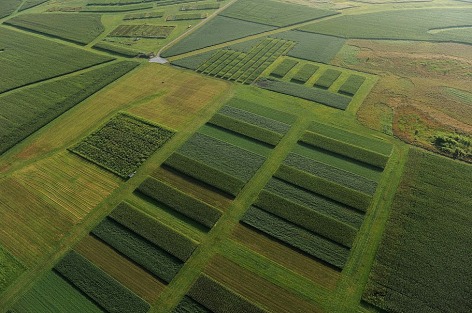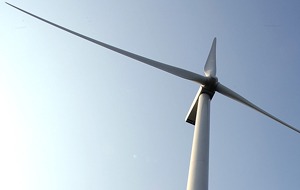
Iowa EPSCoR is supporting studies of biomass production for renewable energy and chemicals. Larger photo. Photo by Iowa State University BioCentury Research Farm.
AMES, Iowa – Iowa’s three Regents universities are making faculty hires, launching studies, partnering with community colleges and building industry partnerships – all in a $22 million effort to boost the state’s research capacity in renewable energy and energy utilization.
The benefits to Iowa could be many: research grants, new technologies, startup companies, educational opportunities and workforce improvements – all contributing to the state’s economic development.
The effort is driven by a five-year, $20 million grant from the National Science Foundation. The grant, announced in September 2011, is from the foundation’s Experimental Program to Stimulate Competitive Research, known as EPSCoR (pronounced Ep-score). The Iowa Power Fund, a state program supporting energy innovation and independence, has also awarded Iowa’s EPSCoR program $2 million to pay for research equipment.
“The alignment of the goals of the grant and the goals of state economic development are very good,” said Jordan Cohen, the chairman of the Iowa EPSCoR State Governance Committee and retired vice president for research and economic development at the University of Iowa.
The grant and the state, for example, are both interested in building capabilities in biosciences and advanced manufacturing, Cohen said.
Robert C. Brown – the original program director for the EPSCoR grant, the director of Iowa State’s Bioeconomy Institute, an Anson Marston Distinguished Professor in Engineering and the Gary and Donna Hoover Chair in Mechanical Engineering – said Iowa EPSCoR has been an organizational challenge over its first year.
“I’m very pleased with the progress we’ve made,” Brown said. “And I’ve been astonished with how complex this project has been. But we’ve reached a stable operating mode for the program and that allows us to focus on the research.”
The first order of business was organizing the leadership and the program across Iowa State University, the University of Iowa and the University of Northern Iowa. That included hiring a chief operating officer – Asrun Kristmundsdottir, based at Iowa State – who joined the program late last year. Brown recently stepped down as Iowa EPSCoR project director to focus more of his time to the research activities of the project. Ted Heindel, the Bergles Professor of Thermal Science in the Department of Mechanical Engineering at Iowa State, is the new EPSCoR project director.
Faculty hires
Another of Iowa EPSCoR’s major accomplishments over the past year has been the hiring of new faculty members poised to launch research programs:
Iowa State University hired Zengyi Shao, an assistant professor of chemical and biological engineering, who studies biocatalysts for biomass conversion; Jean-Philippe Tessonnier, an assistant professor of chemical and biological engineering, who studies catalyst development for biomass processing; and Mark Wright, an assistant professor of mechanical engineering, who studies thermochemical conversion of biomass.
The University of Iowa hired Hongtao Ding, an assistant professor of mechanical and industrial engineering, who studies wind turbine manufacturing; and Hiroyuki Sugiyama, an associate professor of mechanical and industrial engineering, who studies wind energy drivetrain modeling and simulation.
And, the University of Northern Iowa is in the process of hiring a biologist who will study ecological issues in bioenergy.
Research platforms
Iowa EPSCoR is built on four research platforms. All of the platforms have launched and advanced studies over the past year:
Bioenergy platform: Brown, the platform leader, said the platform supported the hiring of three new junior faculty in bioenergy and may hire additional faculty with expertise in economics and microbiology. The platform has two major research emphases: production of biomass and conversion of the biomass to fuels and chemicals. Platform leaders are also talking to federal officials about developing a research consortium in thermochemical technologies, which use heat and catalysts to produce fuels and chemicals.

Iowa EPSCoR is looking for ways to improve wind turbine technology. Larger photo. Photo by Bob Elbert.
Wind Energy platform: The platform supported the hiring of two faculty with expertise in wind turbine technology. The platform is also building a University of Iowa wind tunnel for studies of blade aerodynamics, rotor interactions with surface winds and other wind-turbine studies, said P. Barry Butler, the executive vice president and provost at the University of Iowa and the platform leader. Iowa researchers are also modeling and simulating wind turbine gear tooth failure with the goal of developing effective repairs. Students have also been busy with wind energy projects, Butler said. One example is Daniel Rajewski, an Iowa State doctoral student in geological and atmospheric sciences, who reported to the fall meeting of the American Geophysical Union that carbon dioxide uptake by corn was 10 to 20 percent higher downwind of a large wind farm than it was upwind. Other students have presented wind energy research posters, used field data for their senior theses and contributed to journal papers.
Energy Utilization platform: Heindel, who leads the overall program as well as this platform, said there are two primary research planks, a green community campaign and a building energy initiative. In the first, researchers at the University of Northern Iowa are testing what it takes to change people’s behavior so they are more energy efficient. The second has Iowa State researchers using the Interlock House at Honey Creek State Park – a solar-powered house originally built by Iowa State students for the U.S. Department of Energy’s 2009 Solar Decathlon – as a community research lab and outreach center. University of Iowa researchers are also studying energy efficiency upgrades to Columbus Community High School in Columbus Junction.
Energy Policy platform: The platform – led by Bruce Babcock, the Cargill Endowed Chair of Energy Economics at Iowa State and director of the university’s Biobased Industry Center – has developed a model to show how market prices for biofuels are determined. Data has been reported in papers describing the outlook for ethanol and biofuel prices and assessing the impact of last summer’s drought on crop prices and biofuel production. Platform leaders have also organized a series of events, including a briefing in Washington, D.C., about investment in advanced biofuels. There have also been workshops and seminars designed to promote communication and collaboration between engineers and economists. Platform leaders are making plans for a scientific event to inform policymakers about choices involved in renewing the federal renewable fuels standards.
Broader impacts
Iowa EPSCoR also aims to make impacts far beyond the universities’ research labs, said Chitra Rajan, an Iowa State associate vice president for research, interim director of the Iowa Energy Center and leader of the program’s Broader Impacts activities.
A Future Leaders in Advancing Renewable Energy (FLARE) Institute, for example, has already been established. The statewide institute is designed to develop a skilled and diverse workforce that can meet the needs of Iowa’s emerging green economy.
The program is also working with Iowa’s community colleges to strengthen their courses in science, technology, engineering and math. And, the program is working to identify effective strategies for encouraging women and underrepresented minorities to enter science and technology fields.
Rajan said Iowa EPSCoR is also making connections with industry and policy leaders across the state and the country.
As he looks at all of that, Heindel sees a lot of progress since the launch of Iowa EPSCoR.
“There are a lot of successes that can be highlighted,” he said. “One of the major successes is seeing that a large program can be coordinated among the three Regent universities. As we move forward, the real goal of this project will be to build the state’s research infrastructure so Iowa can be more successful.”